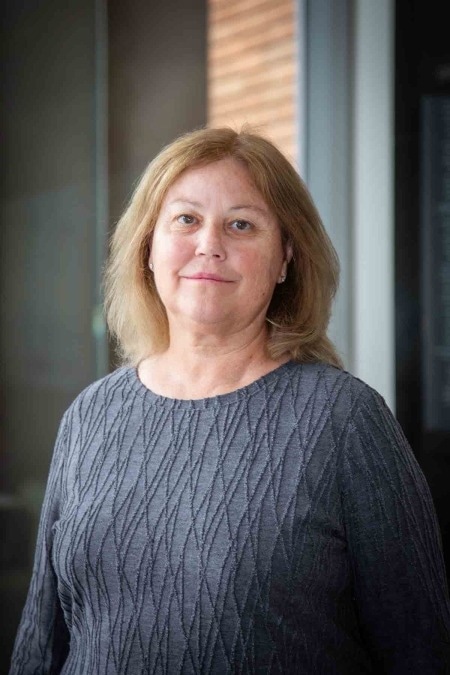In the second year of the Astronomy Faculty Research Fellowship in the university's Bailey College of Science and Mathematics, a research team at Cal Poly will examine extremely high-energy photons emitted by the intense environment found near mega-sized black holes.
 Cal Poly physics professor Jodi Christiansen is the 2024 faculty fellow working with the VERITAS International Collaboration to study very-high-energy photons, or gamma rays, emitted by particles from a supermassive black holes. Image Credit: Cal Poly
Cal Poly physics professor Jodi Christiansen is the 2024 faculty fellow working with the VERITAS International Collaboration to study very-high-energy photons, or gamma rays, emitted by particles from a supermassive black holes. Image Credit: Cal Poly
With the fellowship, faculty members can work with students more closely on scientific research and provide them with cutting-edge research experiences. Thanks to a kind donation covering the program’s three years from the Marrujo Foundation, founded by Cal Poly alumnus Daniel Marrujo and his wife, Rosamaria, it began in 2023.
The 2024 faculty fellow, Jodi Christiansen, is a Physics Professor studying very-high-energy photons, or gamma rays, emitted by particles shooting down an astrophysical jet associated with supermassive black holes.
Christiansen is working with the VERITAS International Collaboration, a division of the Center for Astrophysics, Harvard and Smithsonian. The hottest and most energetic objects in the universe, such as pulsars and neutron stars, supernova explosions, and areas surrounding black holes, release gamma rays.
These gamma rays are extremely energetic, so much so that they can't come from a hot star, which just isn’t energetic enough. What we’re looking at comes from the environment near a supermassive black hole.
Jodi Christiansen, Professor, Physics, VERITAS International Collaboration, Center for Astrophysics, Harvard and Smithsonian
A black hole, usually created when a massive star dies, is a region of extreme gravity from which light cannot escape. Almost everything that is near a black hole is sucked in by it, but some of the material can escape as radiation and particle jets that travel at extremely high speeds.
Without black holes, the accretion disk - a vast field of gas, dust, asteroids, and other matter swirling at enormous speeds around a black hole’s outer boundaries - would not exist. The location of the black hole is revealed by the disk's production of radio electromagnetic radiation, optical infrared, and X-Rays. A portion of this material may be forced out as jets, while the remainder is suctioned into the black hole.
At the Fred Lawrence Whipple Observatory in southern Arizona, VERITAS, or the Very Energetic Radiation Imaging Telescope Array System, uses a set of four 12-m telescopes to collect data from the night sky. The Smithsonian Astrophysical Observatory owns and operates the facility, which makes gamma-ray and cosmic-ray astronomy research possible.
Situated atop 8,553-foot Mount Hopkins, the observatory is close to Amado, Arizona, approximately 40 miles south of Tucson. Christiansen's work has involved remote computer-based imaging analysis in addition to research and viewing trips to the site.
The Cal Poly team has observed particles of plasma that originate from an environment so strong that the “atoms have fallen apart,” according to Christiansen. According to Christiansen, supermassive black holes are found at the centers of most galaxies, and some of them release energy in the form of massive particle stream explosions.
Our images have shown jets that are bigger than galaxies. This jet structure is huge compared to the galaxy. There aren’t a lot of places in space that produce this level of energy.
Jodi Christiansen, Professor, Physics, VERITAS International Collaboration, Center for Astrophysics, Harvard and Smithsonian
According to Christiansen, information about the density and magnetic characteristics of the plasma near the supermassive black hole can be learned from the high-energy gamma rays that reach Earth.
Christiansen says, “There’s still a lot to learn about the physical mechanisms that produce the jets. We do not know why jets are formed. But we are very interested in how that energy can be released from this environment around the black hole.”
Researchers led by Christiansen at Cal Poly have been actively searching for blazars - streams of intense electromagnetic radiation pointed toward Earth - in the last few years.
Christiansen created a software algorithm for the VERITAS telescope a few years ago. This algorithm increases the telescope's resolution by approximately 25% and enables scientists to detect signals with 30% less observing time, improving the ability to find uncommon blazars and other astronomical phenomena.
Elizabeth Jeffery, an Assistant Professor of Physics at Cal Poly, oversaw the first year of the Marrujo fellowship. Jeffery studied information on the positions and luminosities of stars to learn more about their age. White dwarf stars, which mark the end of a low-mass star’s life, were the subject of Jeffrey’s research.
To create the preeminent fellowship ecosystem in the world, the Marrujo Foundation collaborates and supports academic institutions in their efforts to advance astronomy, astrophysics, and cosmology research. The foundation works to make sure that institutional work changes people’s lives in the United States and around the world, challenges our understanding of space, and opens up new opportunities.
The inaugural year of this program has been an amazing journey marked by success, profound insights, and captivating discoveries.
Daniel Marrujo, Former Chief Strategy Officer and Director, Research and Technology Applications, Defense Microelectronics Activity Office
Daniel Marrujo earned a master’s degree in materials engineering and a bachelor’s degree in electrical engineering with a minor in physics from Cal Poly.
Daniel Marrujo says, “The inaugural year of this program has been an amazing journey marked by success, profound insights, and captivating discoveries.”
Delivering microelectronics solutions to the US Department of Defense, Marrujo was the Former Chief Strategy Officer and Director of the Defense Microelectronics Activity's Office of Research and Technology Applications. At the Sacramento-based Trusted Strategic Solutions, LLC, he serves as the managing director and president. The company works with commercial, civil, and national security entities to provide the knowledge and experience necessary to guarantee financial protection, time savings, and safety.